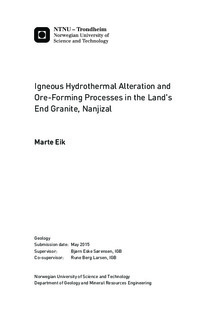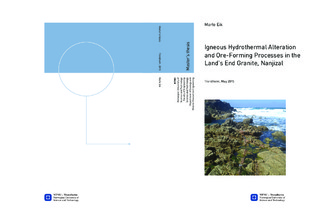| dc.description.abstract | This study addresses the hydrothermal alteration and mineralization related to a system of tourmaline-quartz veins intersecting biotite-granite in Nanjizal, in the Land s End granites of the cornubian batholith. Nanjizal is an important site as it is one of the few locations in the southern segment of the Land s End Granite where magmatic-hydrothermal tin mineralizations have been mined. The aim is to identify the alteration-patterns and their correlation with hydrothermal ore-forming events and the formation of cassiterite ore.
Three vein-types are distinguished from their field appearance, which were mapped and sampled. Petrographic studies (microscopy, SEM, EPMA) and geochemical analyses (XRD, XRF, ICP-MS) were carried out to characterize the alteration types, with focus on tourmaline and rutile as recorders of ore-forming processes and Sn (±W) hosts. Compositional data from tourmaline indicate both reducing and oxidizing conditions.
Three hydrothermal episodes are recognized. The first comprises tourmaline (± quartz) veins, characterized by a red potassic alteration zone, consisting of newly formed K- feldspar-quartz at 400-500 °C. This episode was likely formed by hydrofracturing by high temperature reducing magmatic- hydrothermal fluid exsolved from the magma in a process of second boiling. Rutile and hematite formation and Fe3+ incorporated in the vein-comprising tourmaline indicate the later influence of highly oxidizing fluids. Boiling and subsequent phase separation due to pressure changes probably yielded a high density, oxidizing fluid phase, resulting in cassiterite formation (1000 ppm Sn) and tourmalinization of the vein. The second hydrothermal event comprises tourmaline (± quartz) veins, characterized by sericitic alteration of the feldspars and muscovite replacing biotite. Locally red alteration zone, similar to the first hydrothermal episode, and formation of cassiterite (100 ppm Sn) indicate initial oxidizing conditions and potassic alteration, later overprinted by sericitic alteration of the feldspars by reducing, saline magmatic-hydrothermal fluids. The third hydrothermal episode comprises tourmaline veins and sericitic alteration, from reducing magmatic-hydrothermal fluids. Tourmaline formed during reducing conditions, likely obtaining Fe and Mg from the breakdown of biotite by muscovite-replacement. None of the three hydrothermal episodes show evidence of mixing with cooler, oxidizing meteoric fluids that otherwise yielded the greisen-associated cassiterite deposits described elsewhere in the cornubian ore-field. | |

